Your Ridiculously Easy Guide to Website Conversion Funnels

A friend’s marketing mentor once told him:
“Most businesses waste 50% of their marketing budget on average!”
Maybe that’s true in some cases…
But a conversion funnel (done right) falls into the other 50%—growth.
And every time I look at our bank account (and our clients funnels), I’m reminded of that fact.
The numbers I see there say this: a website conversion funnel in place can turn $1 into $15 (and less or more depending on your business and your market).
Because here’s a simple truth: without a conversion funnel, you’re not marketing...
You’re gambling.
You’re left hoping that you’ll make sales—and that’s a serious mistake.
Unfortunately, if you follow “trendy” marketing gurus, they'll tell you website conversion funnels require a lot of work.
But I’ll open your eyes, baby…
Honestly, converting your “strangers” into loyal customers isn’t actually that hard. You’ve just got to know the steps.
In this 10-step guide, I’m going to simplify what would otherwise be an unnecessarily complicated process for you.
When you follow this “recipe for success”, you’ll be able to get a WORKING website conversion funnel up and running.
It may not be perfect at first. But it will work and you’ll learn how to polish and optimize it over time.
And best of all, you’ll do it in as little as 1 week.
Today, I’m going to tell you…
- How to manufacture leads and sales with the right conversion funnel that’ll practically print you $.
- How to create your own sales funnel from top to bottom, step by step, and why it’ll work for you.
- And how to optimize your conversion funnel after launch to get better and better results.
In 10 steps, you’ll have your conversion funnel up and running.
This is your LAZY marketer’s guide to conversion funnels. And even if you’re not lazy, the point here is to simplify success for you!
It’s almost launch time…
- Understand the Basic Definitions & Conversion Funnel Principles
- Realize that Funnels Actually Work (A Data-Driven Answer Why)
- Study What Works (Then Copy the Best of It)
- Map It Out Using This Checklist (& Avoid this Funnel Conversion-Killing Mistake)
- Important: Understand the Data-driven Reason You Really Need to Pick a Niche…
- Write Your Unique Selling Proposition (USP)
- Then Write All the Copy (Bottom-Up!) in Support of Your USP
- Invest In a Great Design
- Test Launch, & Confirm It Converts (Key Performance Milestone)
- Optimize, A/B Test, & Optimize Again
In a rush? Want to download this article as a PDF so you can easily take action on it later? Click here to download “Your Ridiculously Easy Guide to Website Conversion Funnels” as a PDF guide.

1. Understand the Basic Definitions & Conversion Funnel Principles
Back to basics. What is a conversion funnel really?
It’s basically the same as a sales funnel.
People use both terms interchangeably to refer to the same thing.
So many gurus out there get wrong what a sales funnel is and claim “everything” is a funnel.
Not true.If you’ve read any of my articles, then you know that a sales funnel is a series of steps that lead a prospect from brand awareness to a purchase decision.
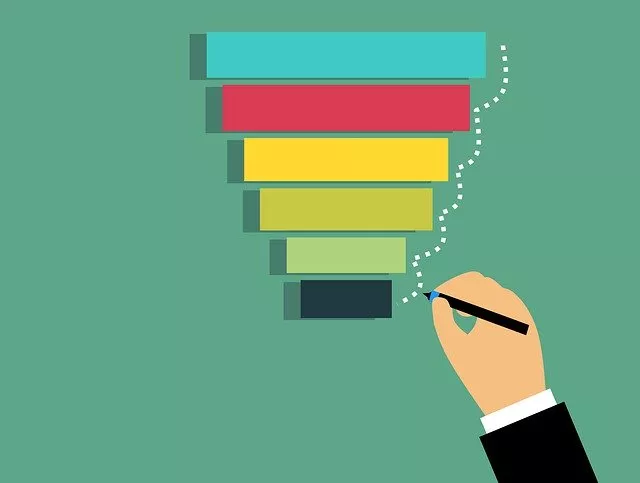
So your website conversion funnel is very simple despite what marketing gurus say.
In order to convert someone who visits your website, you need to:
- Understand their journey through your site.
- Analyze and think critically about the current sales flow of your business.
- Visualize the stages of lead development.
- And identify areas to improve your customers’ conversion rate.
And in order for prospects to navigate through your page and finally hit the “buy” button, they need to follow a specific path along the way.
Think about it like this.
Imagine there was no internet and all sales took place at physical stores.
The first thing you’d have to do as the business owner to make a sale would be to get your audience’s attention.
In other words, you’d set up a huge eye-catching and colorful sign outside your store to catch people’s eyes.
Then, once they walk into your store, you’re going to want to pique their interest.
This is what pretty much every blog article about sales funnel shows as a typical funnel image…

But I prefer teaching you what a sales funnel is and how to convert prospects into customers from a different angle.
No cliché explanations in this article.
This process of awareness, interest, decision, and action that pretty much every sales funnel article teaches you about are the high-level stages prospective customers and clients move through throughout your funnel.
What I’m getting at here is that human relationships (and sales, of course) happen in stages and over time.
And a sales funnel is like a relationship-building machine for selling or generating leads on a massive scale.
You see, with an online sales funnel, it’s all about engaging visitors and getting them to click or opt in to your free offers. You just need to figure out...
- How to create a marketing funnel that actually converts.
- And/or how to improve what you have right now.
And that leads us to our next step.
2. Realize that Funnels Actually Work (A Data-Driven Answer Why)
Before creating your sales funnel, let’s talk about how much time they actually save you.
41% of marketers say that having demo videos on their websites has helped them reduce support calls according to Wyzowl.
Our sales funnel saves us hours of work per day. We save at least 10 hours per week, especially because we have 30,000+ people visiting our site every month.
Having our demo video practically sells our services without much input.
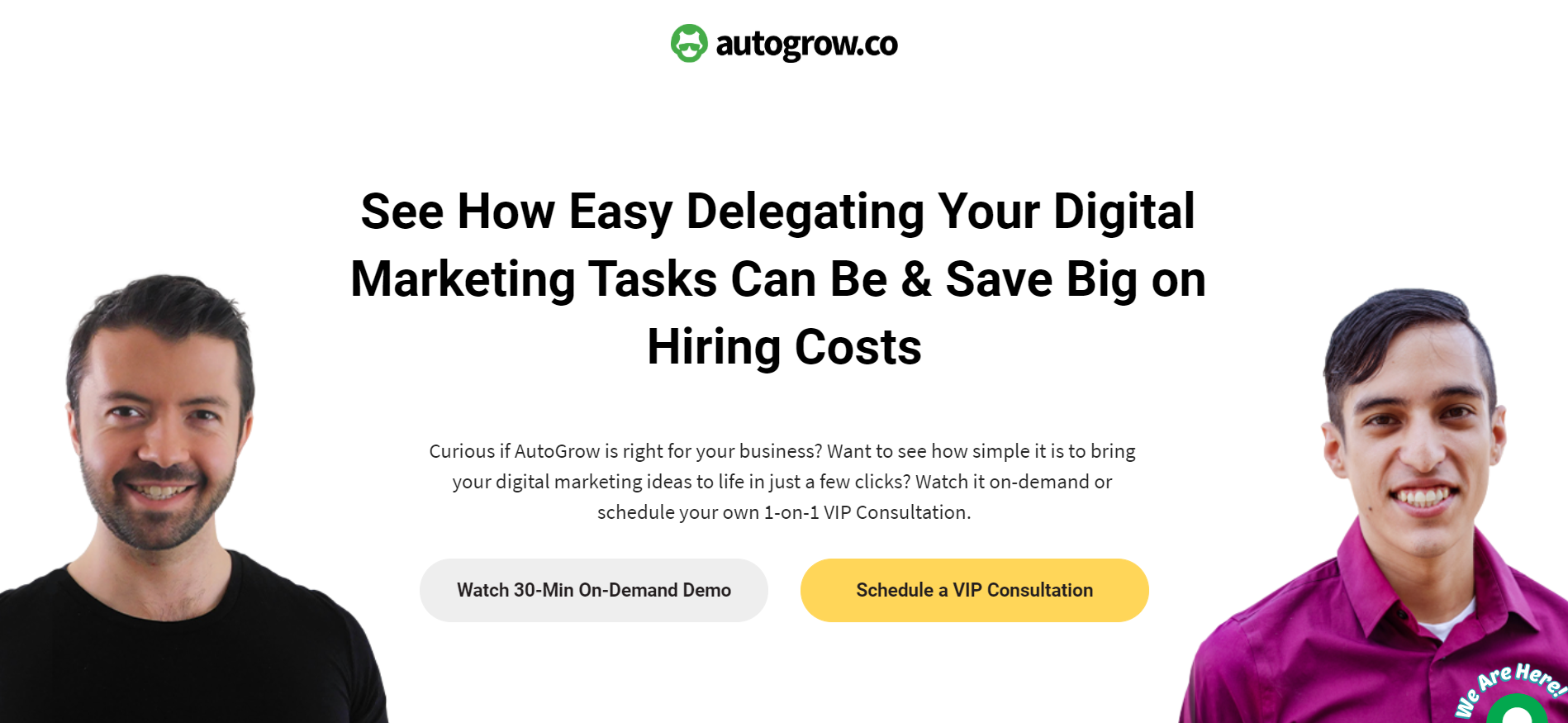
And it’s all about that.
Having the right sales funnel in place automates your lead gen and brings in a consistent flow of leads.
Because the truth is, 96% of visitors who come to your website aren’t ready to buy (yet) according to Marketo.
But a working sales funnel leads to increased growth. Traffic growth, sales growth, and leads growth.
As a matter of fact, according to Salesforce, a full 68% of companies have not identified or attempted to measure a sales funnel.
And that same survey showed that a whopping 79% of marketing leads are never converted into sales.

Coincidence? I don’t think so.
Without a working sales funnel, it’s almost impossible to convert leads into sales.
And it’s no wonder why lead conversion has been pointed out as the most challenging part of a funnel process according to Marketingsherpa.
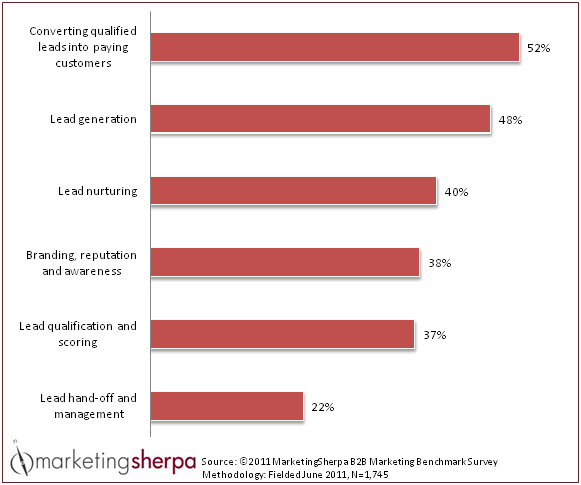
But in order for your sales funnel to work, you must start by mapping your buyer’s path.
Start by defining (and identifying) your funnel stages (more on that coming up).
Doing this has been shown to improve lead gen ROI by 88% on average according to Marketingsherpa.
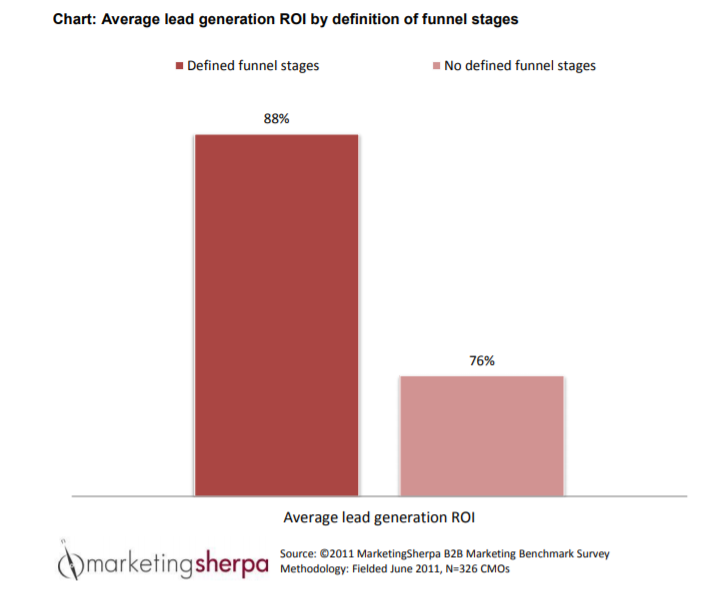
Starting out by defining the funnel stages for your business is key to making your funnel work.
Just take a look at Marketo.

Their revenue-oriented funnel marketing campaign supported a 700% 2-year growth.
And all because this marketing automation solution provider implemented a funnel marketing campaign.
They included lead scoring, nurturing, and content to achieve the massive growth.
The campaign consisted of:
- Defining their marketing and sales process
- Scoring leads based on demographics and on behaviors
- Making content marketing the foundation of lead nurturing
- Handing off from the marketing department to sales representatives
- Analyzing and utilizing customer metrics
The results were impressive:
- Revenue growth of 700+% over 2 years
- 1,000 new customers gained
- $5,800 average cost-per-customer
So now that you know funnels work, let’s keep engineering the right steps to constructing a funnel that brings in a consistent flow of leads and sales.
3. Study What Works (Then Copy the Best of It)
So far, you know the theory. What a conversion funnel is, its benefits, and why you need one.
Now it’s time to copy what works.
And don’t worry, copying here isn’t stealing.
It means seeing what has worked for other businesses and applying it for your own conversion funnel.
That's exactly what we do all the time with our hundreds of sales funnels created for our clients.
If we know a funnel has worked and gotten results for a client in a specific market, then we copy that formula or template. Then, we customize it and make it better for a client with a similar business.
For this, all you have to do is study your competitors.
Look for success patterns. Take them as inspiration. And make your own based on those patterns.
Obviously, the stages of a sales funnel may differ from company to company even if they’re in the same market.
But that’s why you must study them before copying them.
4. Map It Out Using This Checklist (& Avoid this Funnel Conversion-Killing Mistake)
Mapping out your funnel is a great way to visualize customer flow and spot any errors early on.
And a great tool I personally recommend is Google Drawings.

This is a free, easy-to-use tool that lets you create your diagrams.
It’s the exact same tool we use for creating our funnels. This is our funnel for selling high-ticket products and services by the way.

And of course, you can always optimize it later and turn it into a beautifully designed diagram like this…

Want a bulletproof sales funnel that can sell your high-ticket products and services and convert leads like crazy? Click here to download our easy and proven-to-work High-Ticket Funnel Template for FREE now.
Now, mapping out your funnel for the first time can be tricky.
So follow these 11 steps for mapping things out if you sell info products or services. And don’t forget to avoid the one funnel conversion killing mistake (I’ll cover it at the end):
Step 1: Start With What Matters (Your Landing Page)
Create a landing page for your core product offer. Then work backwards.
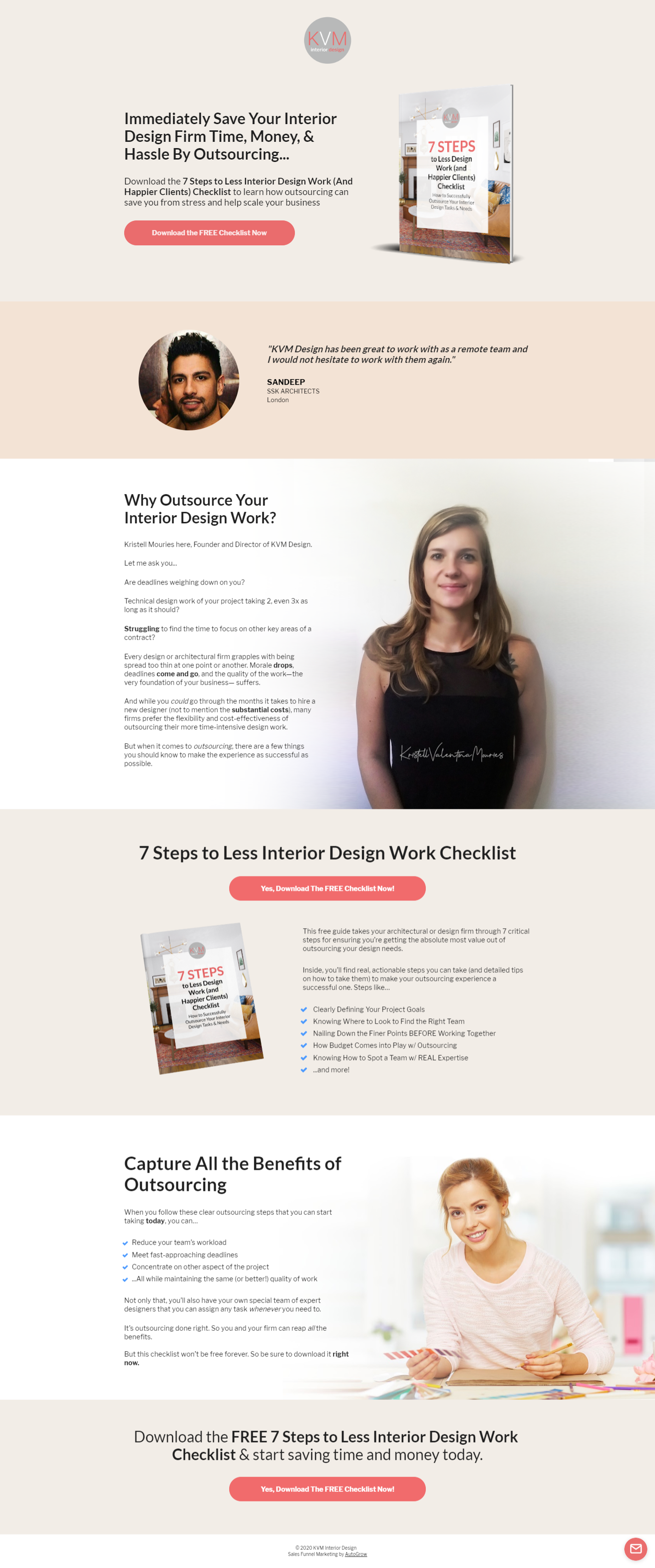
Advanced upsells, downsells, cross-sells, and profit-maximizers come later.

Without a product/service landing page—the foundational funnel element—to focus and speak to prospects, your site will be unable to effectively convert prospects into paying customers.
As a matter of fact, 68% of B2B companies will use landing pages to nurture new sales leads for future conversion according to Marketingsherpa.
Step 2: Create Your Lead Magnet to Entice Prospects
Offer your site’s visitors something for free that leaves them thirsty for more and eager to take the next step in your website—to buy something.

But the important thing here is to offer something that your entire market finds valuable.
You need to understand and define the value of your product or service for that. Then, and only then, will you be able to give your prospects a compelling reason to download your offer.
Your lead magnet is the starting point that will help you segment your list by using different topics and solutions of your larger products or services.
Step 3: Craft Your Tripwire
Create a tripwire or “splinter”—a small offer (usually between $5-$50) sold to new email subscribers after they opt in to your website.

This offer’s meant to accelerate and strengthen the buyer/seller relationship.
When you offer a tripwire, you deliver value for a little bit of money in exchange.
This helps establish a cost-to-value association for the buyer. They know that if they spend a small amount of money, they get a bit of value. And if they spend more money, they’ll get more value.
Step 4: Create Key Landing Pages to Take Prospects Down Your Funnel
Create the essential landing pages you need prospects to land on.
You’ve already created your main services landing page (sales page).
And if you created your lead magnet landing page, then what makes sense now is to build a “Thank You for Downloading Your Lead Magnet” page. Not an “About Us” page.

Focus on the flow of the pages that are the most relevant to your prospects’ journey.
And focus on your lead magnet landing page, thank you page, and sales page. After all, here’s where people will buy your products or services.
Step 5: Set Up an Effective A/B Test for Your 3 Key Landing Pages
Run an A/B test for your lead magnet landing page, your tripwire landing page, and for your sales page.
This will give you valuable insights because you’ll know your customer's behavior and preferences with the data from the A/B test instead of thinking and wondering what might work.
Step 6: Choose the Traffic Source that Will Fuel Your Funnel
Fuel your sales funnel with the right traffic sources.

Will it be paid search ads? Content marketing? Organic search? Social media?
There are tons of traffic sources to choose from. You just need to find the right kind to fit your specific business.
Step 7: Minimize Lost Leads With Automated Follow-Up Emails that Educate Potential Customers
Write your follow-up email sequence with our proven formula.
This set of emails will nurture the relationship with your email subscribers, educate potential customers on the benefits of your products or service, and nudge them to buy from you.

This tactic works really well, especially when people are on the fence.
Step 8: Get Your Message in Front of the Right People By Promoting Content Without Annoying People
Without effective content promotion, few will ever see or find your site.
Think of your content as the fuel for your sales engine. And content promotion is the… IGNITION switch!
Step 9: Track Results to Identify Bottlenecks
Tracking results throughout your funnel is necessary if you want to be able to spot bottlenecks and see where your prospects are dropping out.
Once you spot the problem, you can start testing small but significant changes you can make to your funnel to help boost conversions and optimize.
Step 10: Lengthen the Funnel to Maximize the Value of Every Email Subscriber & Every Customer
I’m talking about… you guessed it!... advanced marketing automation tactics.
Upsells, downsells, cross-sells, profit maximizers, and more.
This is where things get really fun!
With a well-constructed set of upsells, cross-sells, and more, you can increase the average value of each of your customers. Plus, it’s often easier to sell to past clients because you’ve already shown them that you can be trusted.
Step 11: Realize What You’ve Actually Built!
Last but not least, step back and appreciate what you’ve just built by following these steps: a machine that practically prints money, clicks, and leads!
BONUS: Avoid this Conversion Killing Mistake
With your funnel mapped out, it’s time to look at one of the biggest conversion-killing mistakes you can make.
Can you guess what it is?
Having too many steps in your funnel.
We’ve had to learn this the hard way.
We complicated our funnel and our clients’ more than they really needed to be.
Your funnel should be broken down into different stages. This will let you avoid mistakes like offering your lead magnet in your pricing page.
But having more steps in your funnel than you actually need creates more friction.
Friction basically refers to how hard it is for your prospects to get through your funnel
So when friction is minimized and your site’s visitor’s goals are made easier to accomplish, conversions generally go up.
For example, for one funnel we created, we were surveying people who opted in for the lead magnet.
We did this because we wanted to personalize each prospect’s experience as they moved down the funnel and improve the conversion rate.
Well, this tactic didn’t work because of our market.
Perhaps for a different type of business this personalization tactic would have worked well.
But in this case, surveying people created too much friction.
People just wanted to download the freakin’ lead magnet. They didn’t want to fill out a form or answer any questions.
But when we removed this step from the funnel, it completely decreased the friction.
Think about it like going down a water slide.
In order for the ride to be smooth, you need to have some water flowing through the slide.
If you don’t, your skin is going to create some friction with the slide. Your ride won’t be very pleasant. Your skin will hurt. And you’ll want to get off, go home, and never go back again.
Bottom line here, keep your funnel simple. Don’t overcomplicate it and don’t add too many steps.
5. Important: Understand the Data-driven Reason You Really Need to Pick a Niche…
This is a growth multiplier.
Simply pick a specific niche. Even if your business is not niche, just freakin’ niche your funnel.
FitSmallBusiness increased conversions by 1900% using targeted offers according to OptinMonster.
According to MarketingBlender, 73% of consumers report feeling frustrated when your website offers content (ads, promotions, etc.) that has nothing to do with them.
Gone are the days of the hard sell—today’s customer wants relevant, useful information.
And when you give them that, they’ll give you loyalty.
This case study from our Proven Sales Conversion Pack shows that displaying personalized offers to targeted audiences can drive sales up 15%.
Personalization works as long as your offer is aligned with the proper segment of people. And this must be based on specific actions, on-site behaviors, or past buying behavior.
In the case study, a business did an analysis of traffic patterns for another website.
They wanted to figure out which people were likely to buy if they were given a special offer (which wouldn't be profitable if it was shown to everyone).
They wanted to offer a free tire mounting at home to people who were frequent drivers (and therefore, likely to be returning customers in the future).

In short, the personalized offer shown via a pop-up worked because it was aligned with the customer behavior they wanted to target.
Therefore, prospects’ needs matched with the offer. And this grew sales by 15% for the targeted segment.
6. Write Your Unique Selling Proposition (USP)
“If you provide enough value, then you earn the right to promote your company in order to recruit new customers. The key is to always provide value.”

That’s what Guy Kawasaki—who helped Steve Jobs launch the Macintosh computer—said about the importance of providing value when selling your products or service.
But you’re not just selling a product or service here. You’re selling a promise.
A Unique Selling Proposition is a statement that explains what your service does and why it’s different from the competition.
This is essential to hold your visitors’ interest.
It is what sets you apart. It tells your prospect why they should buy from you and not from someone else.
We are all unique in some way, and so are your products or services.
Displaying the authenticity of the Unique Selling Proposition for this website boosted their revenue per visitor by 19.2%.
Before…
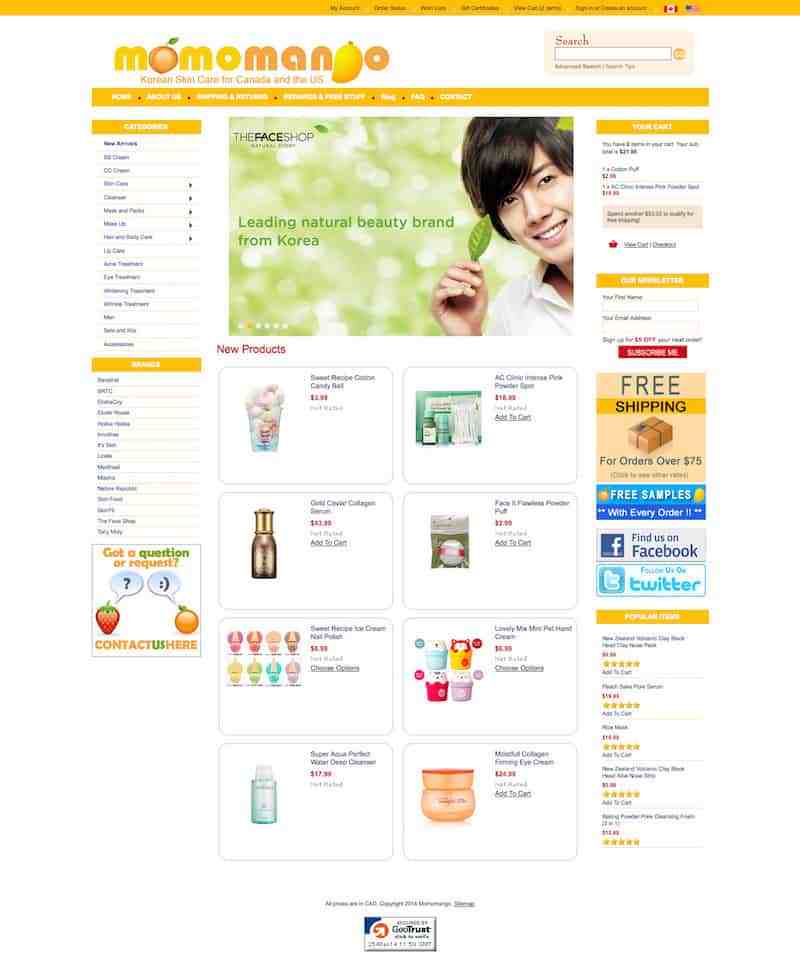
After…
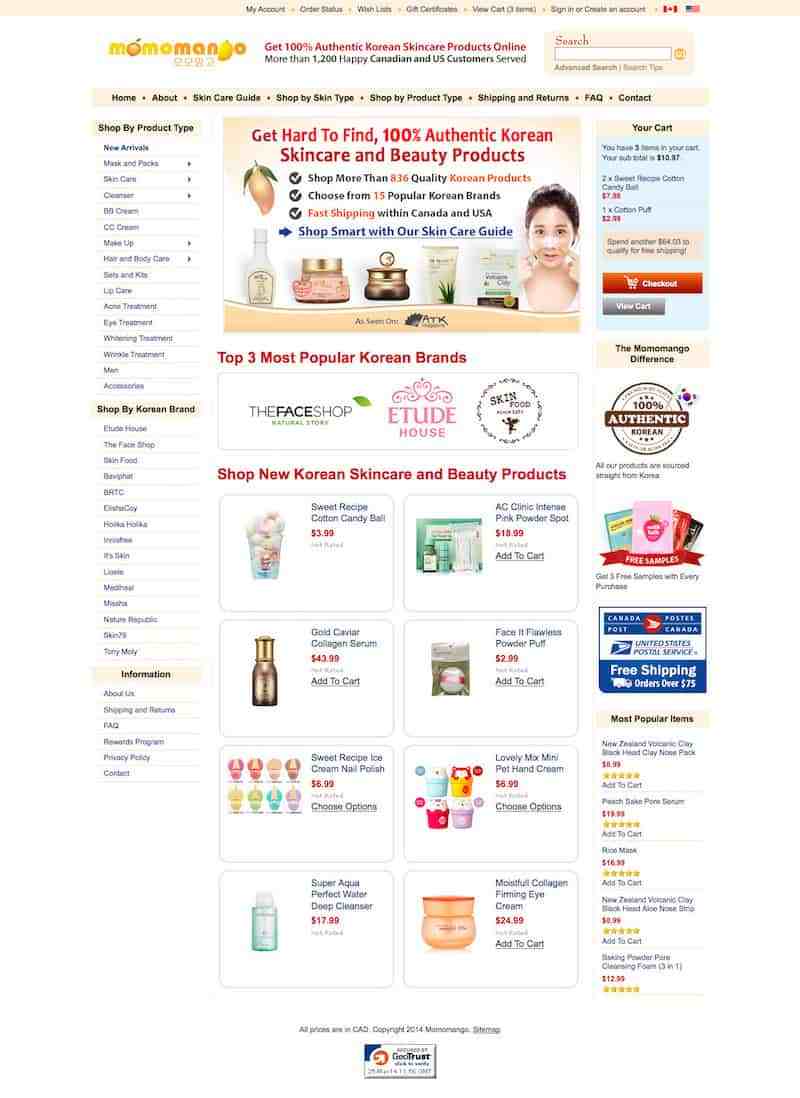
One of the changes made was that the logo included Korean letters. And also, clear copywriting that explicitly communicated the value of shopping at the Korean skincare store was added.

This increased the perception of being authentically Korean.
This helped increase the perceived intrinsic value of buying from the store. And helped the site appear more trustworthy for delivering authentic Korean beauty products.
So for better defining your USP, all you need to do is:
- Be Clear
- Be concise (1–2 sentences)
- Make it a statement that the rest of the copy on your site can support
- Don’t use jargon (speak your customers’ language)
- Describe the end-result in a headline and use the subheadline to give more specifics on the “how”
- Be clear with your target
If you don’t get your USP right, prospects won’t convert. Most likely because they won’t understand what the heck it is that you’re offering.
One way you can from your USP is from the pleasure/pain angle. An entire field of Neuro-Linguistic Programming (NLP) explains that there are two motivation directions that are likely to move people to take action.
- We are programmed to buy something for pleasure.
- We are programmed to buy something to avoid pain.
So in your USP, try to point out how your product or service gives prospects pleasure and protects them from pain.
With that being said, the best value proposition you can offer prospects is the one that your prospect needs.
So, instead of trying to create something you think they could just want, think about what they actually need and deliver the solution to their problems.
A great starting point here is to think from your customer’s perspective based on Maslow’s Hierarchy of needs:
- First physiological (food, water, etc.)
- Then safety.
- And last, love.
Easy to remember, right?
7. Then Write All the Copy (Bottom-Up!) in Support of Your USP
This is a key point.
With your USP written, it’s time to align all of your copy with your USP.
One of the 11 Laws of Sales Funnel Physics—the Law of Alignment—plays a critical role here.
Because if, for example, your ads don’t support your value proposition, or if your lead magnet offer doesn’t align either with your value proposition, then prospects won’t convert.
If your copy talks about something irrelevant to your USP, then your copy will create friction.
Try to think about your visitor’s expectations when they land on your site. And then, fulfill them. Give them what they want to see and read when they land on your pages.
Make sure you’re meeting their expectations by being consistent.
The way you position your product and your brand here as a whole needs to be consistent across all your pages.
But I know writing can be one of the most time-consuming tasks you have to deal with. Especially when you want to nail that perfect copy.
But don’t worry about crafting the perfect copy for your landing pages.
At Growbo, we have the most talented copywriters who can mark off those tasks from your to-do list.
Just check out their work here.
8. Invest In a Great Design
Design is an indicator of value.
If you have a beautiful and customized design (not a template), that’ll attract people to your website.
Your web design amplifies the copy and the whole website.
When the elements from your landing page (text, headlines, logo, images, footer, sub-headlines, etc) are placed randomly or without care, your website won’t meet its goals.
The experience of navigating your site must feel integrated for your prospects. Images shouldn’t be “cookie cutter” or just thrown on the page.
There has to be a connection between your brand, your logo, colors, and the font style and size you choose.
For this, consider investing in high-quality design.
But if you don’t have a reliable team of professional designers who can deliver high-quality designs, then Growbo’s for you.
We have a full-stack team of designers who can create eye-catching designs like this for you…

Or like this…

9. Test Launch, & Confirm It Converts (Key Performance Milestone)
Test everything before launching!
Make sure your funnel, your lead magnet, your transition pages—everything— works properly. That includes making sure all CTA buttons work and all pages redirect to the right pages.
For example, after a prospect downloads your lead magnet, ensure they’ll be redirected to a “Thank you for downloading your lead magnet” page.

Or if for instance, a prospect is on your pricing page, confirm they’ll be landing on the checkout page next.
For all of our clients, we always do at least 3 walk-throughs per client’s funnel before launching.
This helps us identify any errors that could possibly go live and affect conversions.
Once you’re confident your funnel is flawless, launch .
But wait a minute, the work’s not over yet.
Make sure you do a run-through of your funnel after launch.
Here, you’ll be able to catch any possible changes your funnel may need to boost conversions.
It’s part of what we do for each of our clients’ funnels.
After we launch our clients’ funnels, our digital marketing strategists perform regular maintenance. This is to reach those funnels’ full converting potential.
As they click on the ads, scroll through the pricing page, and test the payment system, they evaluate each funnel stage to see if something needs to be updated.
Let’s say you’re offering a lead magnet that says “Your 9-Point Perfect Checklist to Promote Content in Instagram in 2019”. But we’re already in 2020. That outdated year could be hurting your conversions.
So checking on your funnel’s performance is key to improving its conversion.
Because even when you test it and launch it and seems to work fine, the truth is, there can always be room for improvement along the road.
10. Optimize, A/B Test, & Optimize Again
You have your funnel in place at this point. Congratulations for that!
But the work’s still not over—yet.
Now you need to iterate on it. A/B test it. Optimize it.
I’ve mentioned in the past how by A/B testing two variables of our copy on the homepage, conversions increased by 80%.
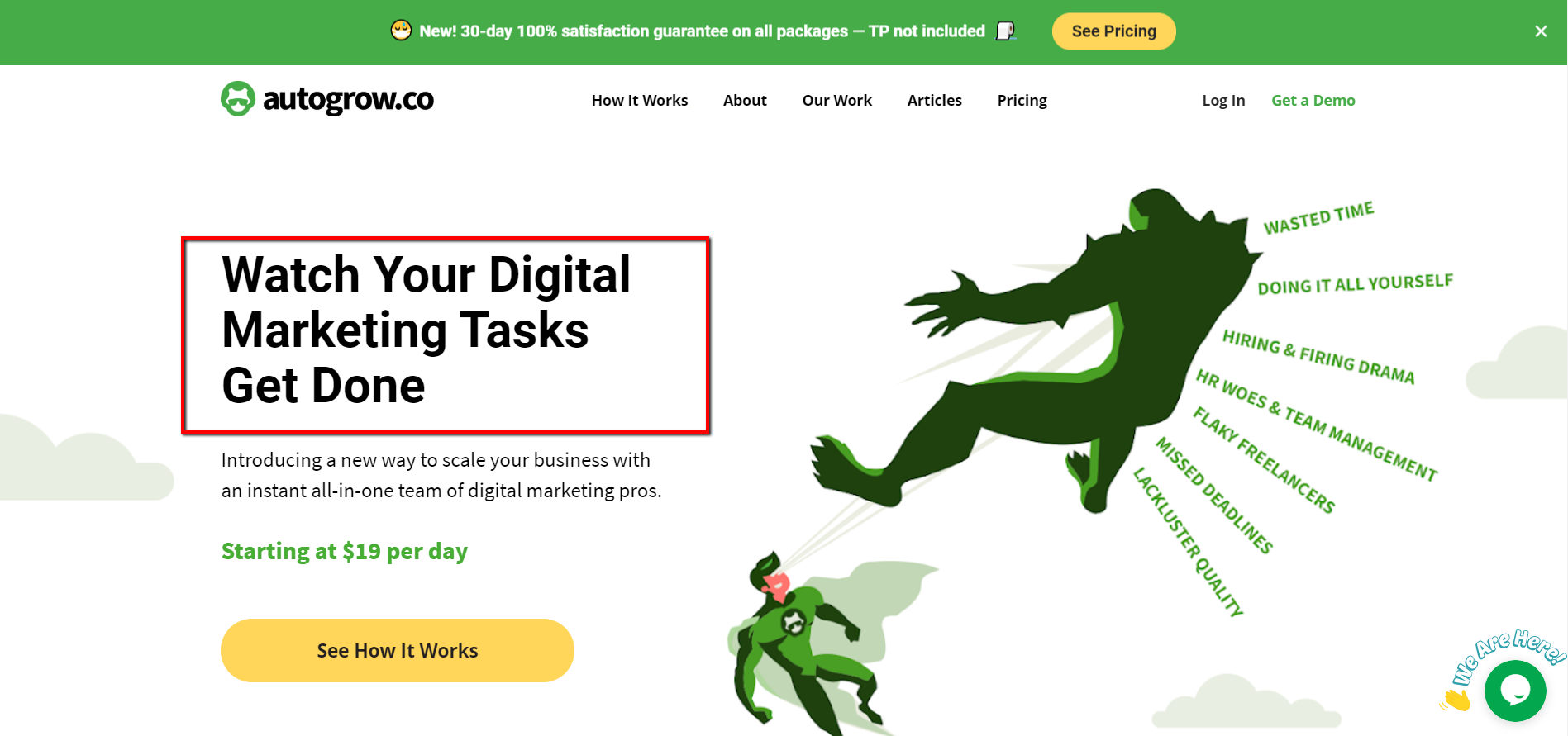
And if you’re a bit skeptical about how A/B testing can actually boost your conversions, then check out our Proven Sales Conversion Pack.

This is a curated collection of 313 credible, easy-to-copy conversion optimization case studies.
It's like a sortable and searchable library of proven sales-boosting tactics. It has tweaks and "tricks" that you can copy in a matter of minutes.
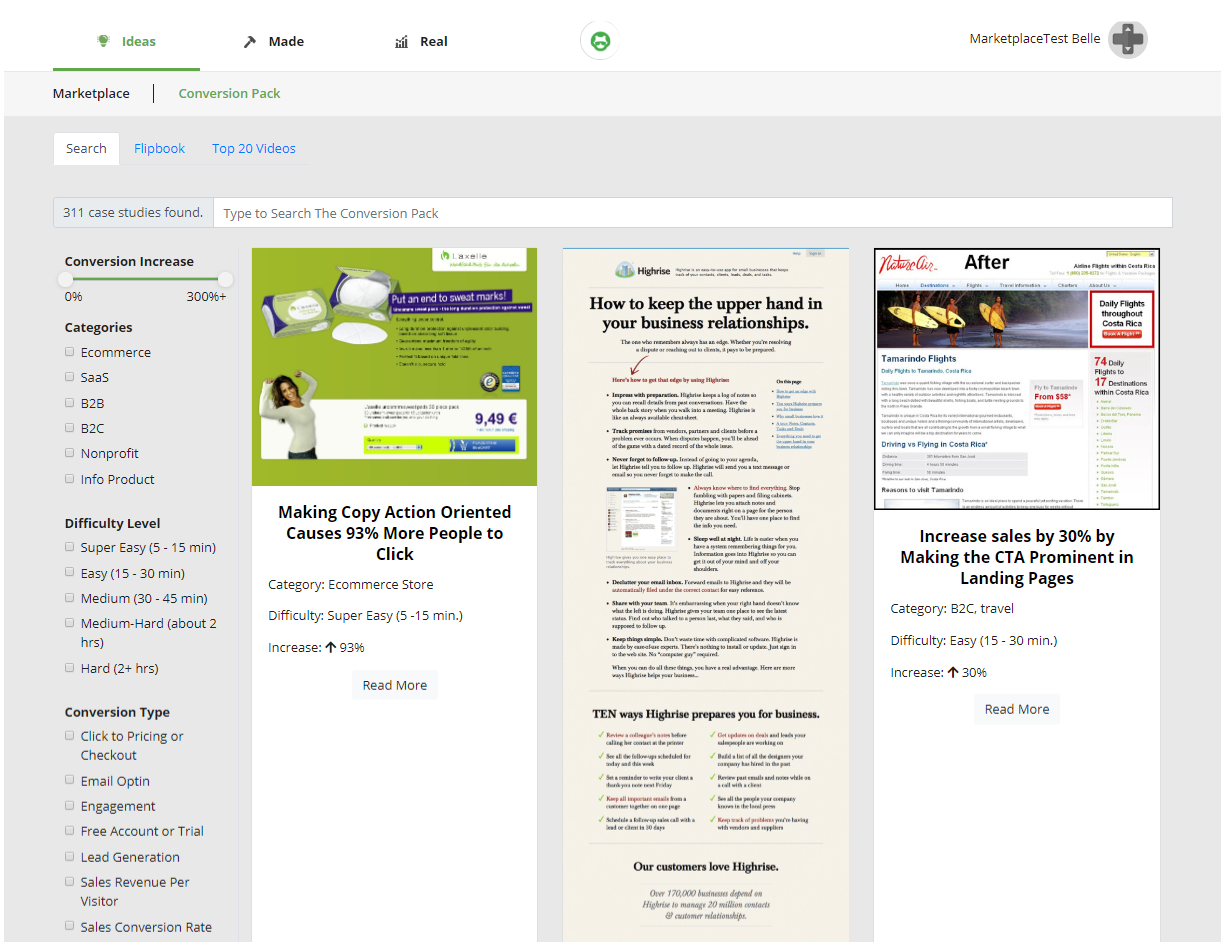
But why should you optimize your funnel in the first place?
Your goal when optimizing your sales funnel is to get more conversions. More leads. More sales.
Think of it like sharpening a kitchen knife. You rub it against the sharpener again and again and again. And each time you do, it gets a little sharper.
Optimizing your funnel is the same way. Implementing small tweaks again and again can help boost the converting power even further.
Plus, you’ll also want to optimize for better lead qualification.
Because having more traffic coming into your funnel and maybe even booking calls doesn’t really mean that they’ll buy.
You need to optimize to get more qualified leads. Qualification is more important than quantity. Period.
For instance, when optimizing your sales funnel, consider making the following tweaks:
1. Write More Clear CTAs:
Aligning your CTA buttons doesn’t mean to align them left or right. It means that that which clearly lines up with other landing pages and with your prospects’ expectations is more likely to sell.
Alignment refers to meeting expectations. It’s offering your site’s visitors whatever they’re expecting to see and read about when they visit your landing pages.
Alignment guides prospects through your funnel. It deals with their intentions and questions.
So set the right expectations for your prospects with your CTA buttons’ text.

If you’re meeting people’s expectations, then you’re in alignment with your offer. Therefore you’re aligned with your potential buyers’ preferences.
2. Reframe Your Lead Magnet:
Check the performance of your lead magnet (how many people have downloaded it). If you see low conversions, consider reframing your offer.
Offering a low-converting lead magnet can become a bottleneck for your funnel.
Why?
Because if people don’t opt in for whatever your lead magnet offer is (ebook, checklist, etc.), they’ll likely drop off. This means they won't continue down your funnel.
For instance, just reframe it as another type of lead magnet.
This simply means that if, let’s say, you're offering an ebook but no one’s downloading it, reposition it as a guide.
It’s a simple change that can end up netting you a surprising amount of new traffic.
3. Add Some Humanity to Your Funnel
This one’s very simple.
People love seeing the faces behind a brand. They love knowing who they’re working with. They want to know who’s writing this article (hint: Matt ).
So in order to help meet your prospects’ expectations, humanize your website.

Add personality to the copy and write in a conversational tone.
Use images (especially add people’s faces). Use humor, sarcasm, or language that creates empathy and connects with your audience.
4. Offer a Second Version of Your Lead Magnet
People love choosing between options.
It makes it fun, right?
Think of it like this:
Choosing from a variety of sizes and colors of clothes...
vs.
Choosing the one and only polo in a one-size-fits-all size left at the store…
Which sounds more appealing?
You get it.
Well, prospective customers who visit your website also like variety.
For example, if your lead magnet offer is an ebook, consider offering it in an audio version too.
That’s what we did with our “Productize & RELAX” ebook.

We offered not only a written version but an audio version and people loved it.
And you want to know why?
Because they weren’t stuck with only one option.
5. Add More Form Fields
Increasing the number of form fields on your opt-in can boost your conversions.
Doing so actually increases the perceived value of the product.
But don’t go crazy. Adding too many form fields can lead to the opposite effect too.
Just take a look at this example.

They actually saw a 120% jump in conversions just by adding fields for a first name and an email address.

Now tell me something, is it worth adding more form fields or not?
The answer is: it depends on your audience.
So A/B test both options on your website. You may be surprised at the results.
Conclusion
Download the
Congratulations on making it all the way to the end!
If you follow those 10 easy and actionable steps, you’re going to build a funnel that practically prints money and leads…
- Understand the Basic Definitions & Conversion Funnel Principles
- Realize that Funnels Actually Work (A Data-Driven Answer Why)
- Study What Works (Then Copy the Best of It)
- Map It Out Using this Checklist (& Avoid this Funnel Conversion-Killing Mistake)
- Important: Understand the Data-driven Reason You Really Need to Pick a Niche…
- Write Your Unique Selling Proposition (USP)
- Then Write All the Copy (Bottom-Up!) in Support of Your USP
- Invest In a Great Design
- Test Launch, & Confirm It Converts (Key Performance Milestone)
- Optimize, A/B Test, & Keep Optimizing
If your goal is to manufacture more leads and sales while feeling in control of your digital marketing destiny, then this guide is going to take you a few big steps forward on that journey.
And best of all, you can apply this guide in less than a week and see massive results instantly.
Now tell me something. Did anything in the steps I shared surprise you?
Did you recognize any mistakes you’re making in your own funnel?
Do you now have a better understanding of what you can do to fix it?
Let me know in the comments below.
Keep Growin’, stay focused,














